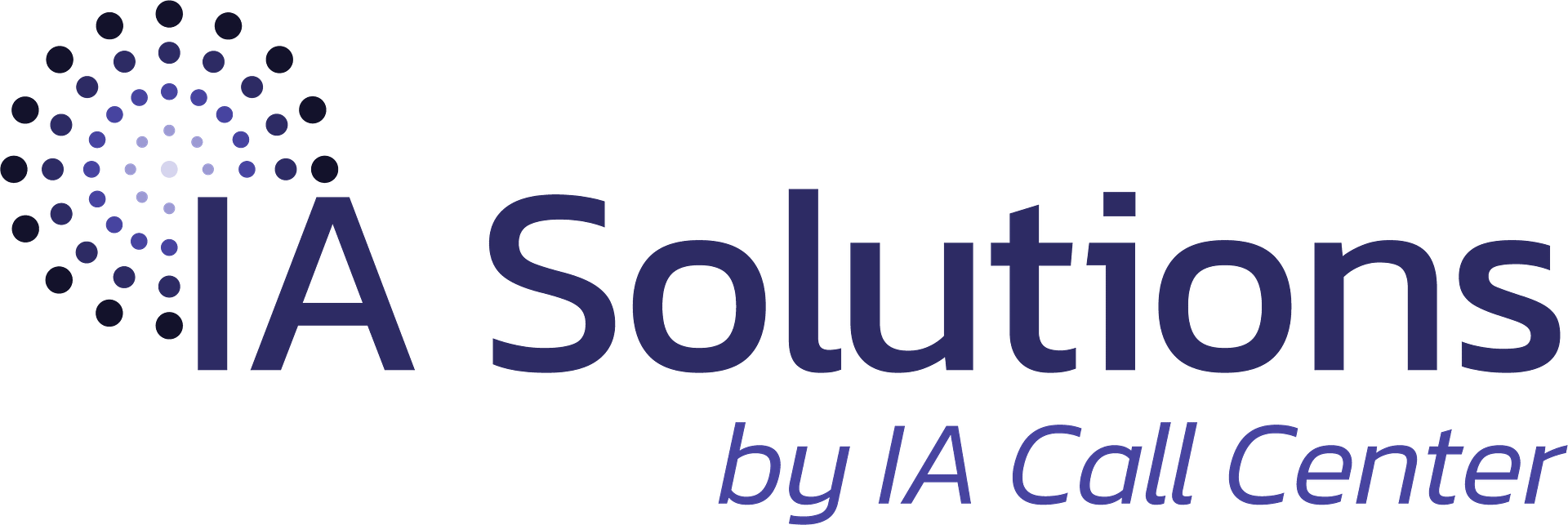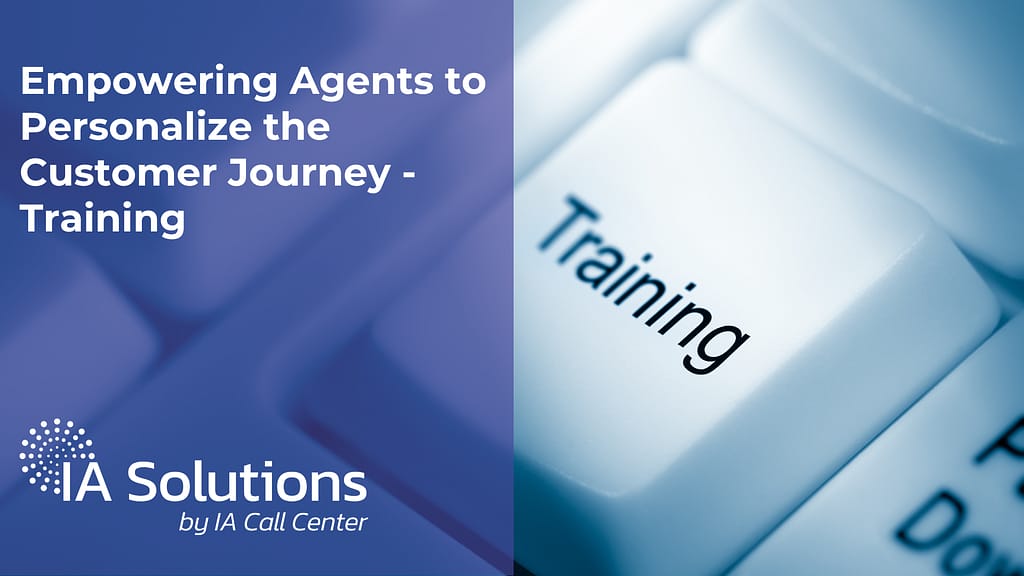Empowering Agents to Personalize the Customer Journey – Agent Training
Want to listen to the post instead? Click play to hear it now.
(Note – This is the fifth post in our series, “Empowering Agents to Personalize the Customer Journey Agent Training.” If you missed the last one, “Phrasing and Scripts,” please click here to view it now. We are releasing new posts for this series every week. Therefore, please be sure to enable notifications to receive updates when we post new articles.)
Introduction
Today, life moves fast; and if you want your business to succeed, you need to move even faster. Therefore, your business must meet customer demands as quickly and efficiently as possible. Why? Because your customers expect a seamless experience when interacting with your business.
When customers need service or support, they want to be able to switch between different channels, such as social media, email, phone, and live chat, and still receive a consistent and personalized customer journey and service. This is where omnichannel customer service comes in.
Omnichannel services provide customers with a unified experience across all channels, allowing them to engage with your brand on any platform they prefer. However, to deliver an effective omnichannel customer journey and experience, your company must invest in proper agent training.
In this article, we’ll discuss why proper training methods are important for omnichannel agents, the benefits of good training, how to evaluate those methods, and some of the best omnichannel training methods. So, let’s begin.

Why Proper Training Methods are Important for Omnichannel Agents
Effective omnichannel customer service requires that agents clearly understand the customer journey and the different touchpoints customers may use to connect to your brand. Additionally, your agents must be able to provide personalized and consistent service across all channels and switch between those channels seamlessly. Proper training methods are important for omnichannel agents because they provide the knowledge and skills necessary to meet these requirements.
According to a study by Zendesk, “90% of customers expect consistent interactions across channels,” but “86% of customers say they need to explain their problem multiple times.”
Effective training techniques can help agents comprehend and use the different channels successfully, decreasing the need for customers to repeat themselves and elevating their overall satisfaction with the service they receive.
Furthermore, training needs to encompass a broad range of topics, such as comprehending customer expectations, making the most out of various channels, maneuvering through different platforms, and responding to customer behavior. Consequently, without the right instruction, agents may find it difficult to deliver a uniform and personalized customer journey, which could lead to customer dissatisfaction and damage your brand’s reputation.
Benefits of Good Training for Omnichannel Agents
Investing in effective training methods for omnichannel agents has many benefits. Here are just a few:
Improved Customer Satisfaction
When agents are knowledgeable in their role, they can deliver personalized and dependable service on all communication platforms. As a result, customers become more satisfied when they feel their input matters.
In a recent study, HubSpot found that, “68% of customers leave because they believe that companies don’t care about them.” Proper training can help to prevent this by providing agents the ability to give a personalized and caring journey that makes customers feel appreciated.
Increased Efficiency
Agents with adequate training can effectively manage multiple channels, reducing wait times and improving productivity. This shortens how long it takes to resolve issues, which is a great way to keep customers happy.
The Aberdeen Group conducted a study demonstrating that companies with a uniform service experience across a variety of channels experienced a 91% higher increase in customer retention rate year over year.
Investment in superior training for your agents can boost your company’s capacity to provide a consistent service experience across multiple channels.

Enhanced Brand Reputation
Customers who have had a positive experience with your brand are likely to encourage others to try it. Hence, agents that are well-trained can help create a better public image for your brand and encourage customer loyalty.
If a company can increase customer retention by 5%, profitability rises by 75% – according to a study conducted by Bain & Company. Offering a dependable and pleasant service experience across all platforms can lead to customers staying loyal and boosting profitability in the long run.
Improved Agent Retention
Well-trained agents are more likely to feel confident in their abilities and to enjoy their work. The consequence of this is improved agent retention, which in turn decreases the costs of employee turnover.
A Glassdoor study concluded that a 10% increase in employee retention can result in a 30% gain in the value of a company. Therefore, your company can strengthen its ability to keep your best employees and lessen the costs of turnover when you invest in good training for agents.
How to Evaluate Training Methods
It is essential to review training methods to make sure they are working and addressing the requirements of agents and customers. Here are a few points of thought when looking at training methods:
- Engagement: Are agents engaged and actively taking part in the training? Does the training involve active participation?
- Feedback: Do agents receive any feedback regarding their performance during training? Are the comments constructive and productive?
- Relevant: How applicable is the training to the jobs the agents will be doing and the communication platforms they will utilize?
- Retention: Are the agents retaining what they learned in the training? Can they put the knowledge they have acquired to practical use?
- ROI: Is the training providing a profitable return on investment? Are there measurable improvements in agent performance and customer satisfaction?
Best Omnichannel Training Methods
Now that you have a better understanding of why proper training methods are essential, the advantages of good training, and how to assess training methods, let’s explore the most effective omnichannel training methods.
Blended Learning
Blended learning combines traditional classroom learning with online learning. This approach allows agents to learn at their own pace and on their own schedule, while still having access to a trainer for support and feedback. For example, your company might provide an online course on customer service basics, followed by an in-person training session where agents can practice their skills and receive feedback from a trainer.
An ATD study concluded that blended learning programs can increase learner retention by up to 35%. Combining multiple learning approaches, blended learning can help raise retention rates and ensure that agents remain interested in the training process.
Role-playing
Role-playing is a great way to simulate different customer scenarios and practice different approaches. This allows agents to trust their talents and be better prepared to handle customer interactions when taking live calls. For instance, a trainer could portray an angry customer, and the agent would need to practice reducing the tension and finding an outcome that meets the customer’s desires.
Training Magazine’s study showed that role-playing is the most successful way to build interpersonal skills. Agents can sharpen their skills in a secure, supervised atmosphere through role-playing, which can then help them positively interact with customers in a way that is both productive and effective.
Gamification
The training process can be made more engaging by adding game elements such as rewards and points. This type of gamification can make training more interesting and entertaining, while also stirring agents to learn and remember facts. For instance, you might create a leaderboard where agents can compete to earn points by completing training modules or demonstrating certain talents.
TalentLMS conducted a study that revealed gamification can increase involvement in training programs by up to 50%. By making training more enjoyable through gamification, agents are more likely to remember what they learn and stay with the company for longer.
On-the-job Training
Learning through hands-on experience in the workplace, on-the-job training allows agents to hone their skills in a real-world situation and to receive feedback and guidance from more experienced agents. For example, your company might match a fresh agent with someone more experienced for a period of time to assist them in becoming familiar and learning the ropes.
Brandon Hall Group conducted a study and discovered that on-the-job training is the most successful way to improve job performance. By giving agents the opportunity to practice their talents in a practical setting, on-the-job training can assist in enhancing their capacity to deal with customer interactions effectively and quickly.

Coaching and Mentoring
Experienced mentors or coaches are brought in to coach and mentor agents, offering direction and support as less-experienced agents learn their roles. This approach can be particularly effective for agents who are new to the job or encountering problems with specific aspects of their role.
A study done by the International Coach Federation shows that coaching can increase work performance by as much as 70%. With the proper resources and mentoring, agents can increase customer happiness and remain in their positions.
Microlearning
Microlearning means dividing training into smaller, more manageable segments. With this system, agents learn on-the-fly and as needed, while also simplifying the process of slotting training into their busy schedules. For example, your company could come up with brief video tutorials on distinct topics, like how to deal with a specific customer issue or how to use a certain channel successfully.
A Bersin by Deloitte study reported that microlearning may result in up to a 20% increase in retention rates. By dividing training into small, easy to comprehend parts, microlearning can assist agents in retaining more knowledge and utilizing it more effectively in their job.
Continuous Training
Ongoing training and development opportunities are a key component of continuous training. Thus, using this technique ensures that agents have the most modern technologies and procedures and encourages them to keep improving their abilities over time. For instance, your business could pair a fresh agent with a more seasoned agent who can offer guidance and assistance while managing difficult customer interactions.
Research from LinkedIn found that businesses with a strong learning culture have a 46% higher retention rate versus companies that do not. Accordingly, by investing in continuing education for agents, you can enhance agent retention, reduce turnover costs, and make sure your agents are aware of the most recent trends and technologies.
Summary
Delivering a seamless omnichannel customer experience requires well-trained agents who can provide personalized journeys and consistent service across all channels. However, achieving this goal requires the right kind of training. Therefore, investing in successful training methods can bring about customer delight, a better brand name, and higher agent retention.
To get the best results in omnichannel training, use a combination of blended learning, role-playing, gamification, on-the-job training, coaching, microlearning, and continuous training.
It is essential to review training methods to ensure that they are working and meeting the requirements of agents and customers. Accordingly, by utilizing these omnichannel training approaches, your company can arm agents with the education and abilities they need to personalize the customer journey and provide a world-class omnichannel customer experience.
In the next post of our Empowering Agents to Personalize the Customer Journey series, we will discuss agent autonomy in the omnichannel process. Therefore, if you want to find out more about how letting agents make decisions helps them personalize the customer journey more effectively, be sure to check back a few days after this post.
Sources:
- Zendesk’s “Omnichannel Customer Support Report”
- HubSpot’s “State of Customer Service in 2022”
- Aberdeen Group’s “The Power of Customer Experience Management in 2020”
- Bain & Company’s “Putting the Service-Profit Chain to Work”
- Glassdoor’s “Why Do Employees Stay? A Clear Career Path and Good Management”
- ATD’s “Blended Learning: Best Practices, Benefits, and Considerations”
- Training Magazine’s “What Makes Training Work”
- TalentLMS’s “The 2019 Gamification at Work Survey”:
- Brandon Hall Group’s “Best Practices in Onboarding and Performance Management”
- International Coach Federation’s “2016 ICF Global Coaching Study”
- Bersin by Deloitte’s “The Corporate Learning Factbook”
- LinkedIn’s “2018 Workplace Learning Report”















